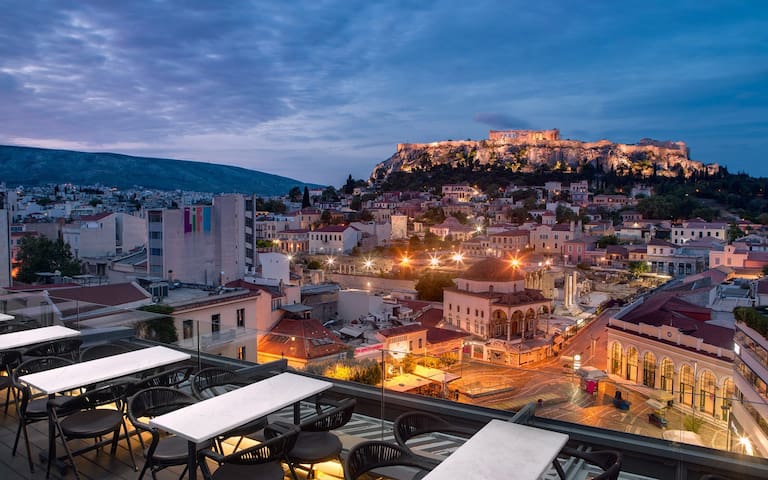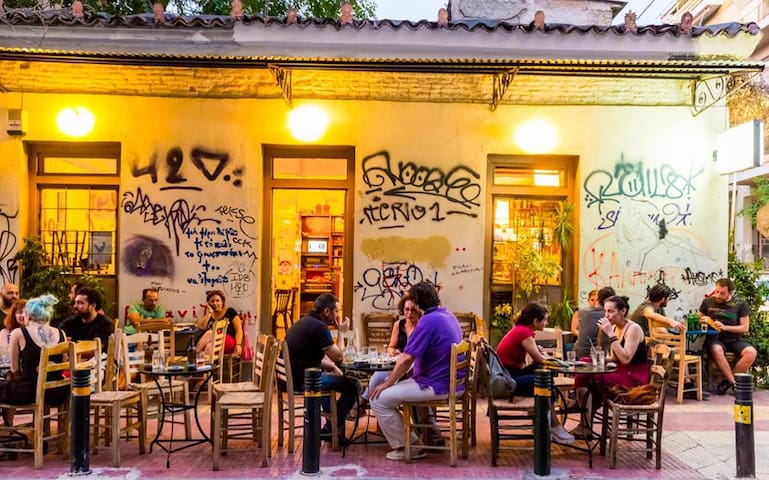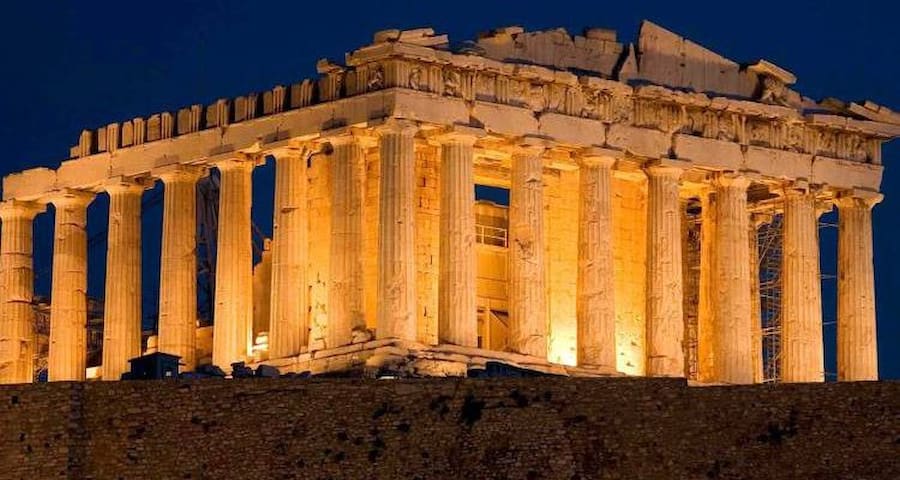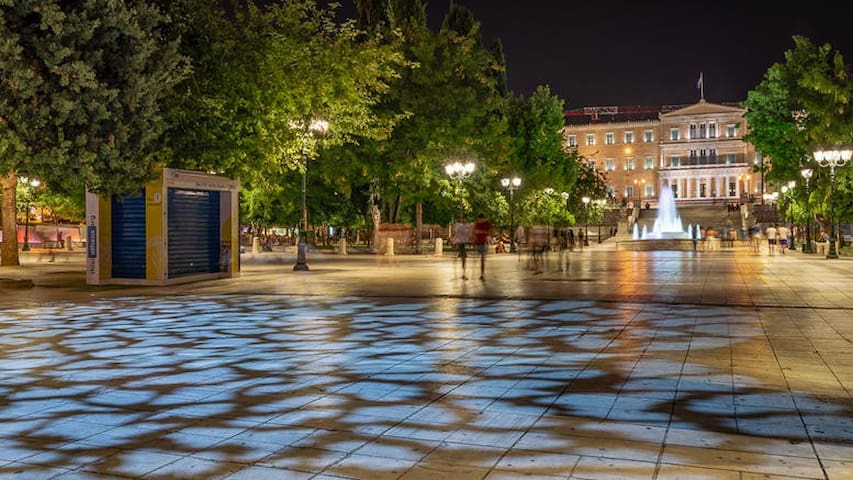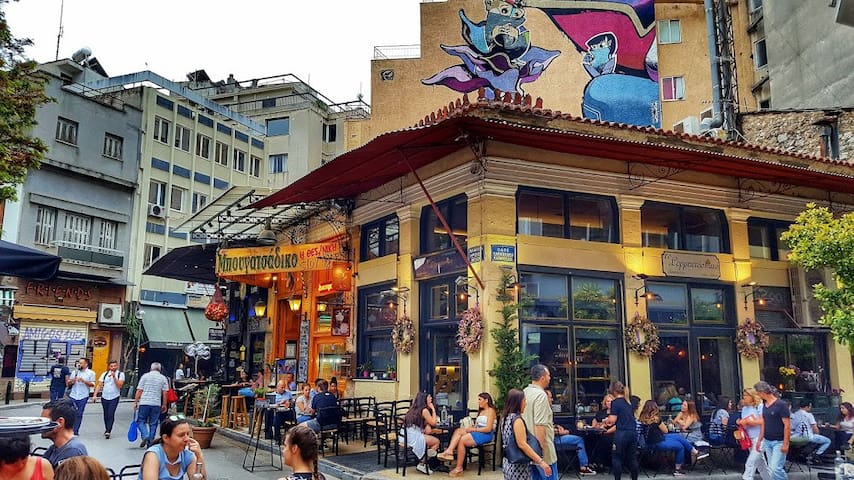Food-beers-wine
food@wine very popular area
360 Cocktail bar
2 IfestouNear to metro monastiraki ..
A for Athens Cocktail Bar
2 MiaouliBlue Parrot
31 LeonidouCool place for coffe , wine , beer
Kampethón
110 Keramikoufood -wine @ beers 1000 met from apartment
Seychelles
49 Keramikouvery good food -wine -beer ..must make a call first for reservation
Elvis
29 Plateontraditional Greek souvlaki
Tranzistor
10 Protogenousafter 6pm very popular for beer and food.
Thissio View
25 Apostolou PavlouKeramikos
Very popular area with bars @ restaurants for fridays and Saturdays
SOUPER MARKET
Super Market Kritikos
91 Platonossuper market 150 met from apartment
Popular Areas
Very popular area close to Acropolis
at the shadow of the Acropolis is Plaka, the most picturesque and oldest district of Athens, which was continuously inhabited from antiquity to the present day. The neighborhood of gods, as it was called, resembles a journey to old Athens with antiquities, historical buildings and Byzantine churches. Unique in every respect is the Cycladic neighborhood od Anafiotika, which was built by craftsmen and workers from the island of Anafi when they arrived in Athens after the liberation. The tiny whitewashed houses among the rocks, the gardens with the flowers, the narrow alleys and the mazy planning is similar only to the one found in Cycladic islands.
323 locals recommend
Anafiotika
Very popular area close to Acropolis
at the shadow of the Acropolis is Plaka, the most picturesque and oldest district of Athens, which was continuously inhabited from antiquity to the present day. The neighborhood of gods, as it was called, resembles a journey to old Athens with antiquities, historical buildings and Byzantine churches. Unique in every respect is the Cycladic neighborhood od Anafiotika, which was built by craftsmen and workers from the island of Anafi when they arrived in Athens after the liberation. The tiny whitewashed houses among the rocks, the gardens with the flowers, the narrow alleys and the mazy planning is similar only to the one found in Cycladic islands.
The Acropolis of Athens is an ancient citadel located on a rocky outcrop above the city of Athens and contains the remains of several ancient buildings of great architectural and historic significance, the most famous being the Parthenon. The word acropolis is from the Greek words ἄκρον (akron, "highest point, extremity") and πόλις (polis, "city").[1] Although the term acropolis is generic and there are many other acropoleis in Greece, the significance of the Acropolis of Athens is such that it is commonly known as "The Acropolis" without qualification. During ancient times it was known also more properly as Cecropia, after the legendary serpent-man, Cecrops, the supposed first Athenian king.
While there is evidence that the hill was inhabited as far back as the fourth millennium BC, it was Pericles (c. 495–429 BC) in the fifth century BC who coordinated the construction of the site's most important present remains including the Parthenon, the Propylaia, the Erechtheion and the Temple of Athena Nike.[2][3] The Parthenon and the other buildings were damaged seriously during the 1687 siege by the Venetians during the Morean War when gunpowder being stored in the Parthenon was hit by a cannonball and exploded.
10 locals recommend
Akropoli
The Acropolis of Athens is an ancient citadel located on a rocky outcrop above the city of Athens and contains the remains of several ancient buildings of great architectural and historic significance, the most famous being the Parthenon. The word acropolis is from the Greek words ἄκρον (akron, "highest point, extremity") and πόλις (polis, "city").[1] Although the term acropolis is generic and there are many other acropoleis in Greece, the significance of the Acropolis of Athens is such that it is commonly known as "The Acropolis" without qualification. During ancient times it was known also more properly as Cecropia, after the legendary serpent-man, Cecrops, the supposed first Athenian king.
While there is evidence that the hill was inhabited as far back as the fourth millennium BC, it was Pericles (c. 495–429 BC) in the fifth century BC who coordinated the construction of the site's most important present remains including the Parthenon, the Propylaia, the Erechtheion and the Temple of Athena Nike.[2][3] The Parthenon and the other buildings were damaged seriously during the 1687 siege by the Venetians during the Morean War when gunpowder being stored in the Parthenon was hit by a cannonball and exploded.
Also called the Hill of the Muses, Filopappou Hill – along with the hills of the Pnyx and the Nymphs – is a somewhat wild, pine-shaded spot that's good for a stroll, especially at sunset. The hill also gives some of the best vantage points for photographing the Acropolis, and views to the Saronic Gulf.
145 locals recommend
Filopappou
Also called the Hill of the Muses, Filopappou Hill – along with the hills of the Pnyx and the Nymphs – is a somewhat wild, pine-shaded spot that's good for a stroll, especially at sunset. The hill also gives some of the best vantage points for photographing the Acropolis, and views to the Saronic Gulf.
The Plaka is the oldest section of Athens. Most of the streets have been closed to automobile traffic, though you should still keep a watchful eye for a speeding motorcycle or delivery truck. At one time it was the nightclub district, but most of these closed down when the government outlawed amplified music in the neighborhood in the seventies in an effort to get rid of undesirables. The strategy was very successful and it is now an area of restaurants, Jewelry stores tourist shops, and cafes. Though it is quite commercialized it is still a neighborhood and arguably the nicest neighborhood in central Athens. Most of the restaurants are typical tourist places but the quality of food is not bad in some of them and if you follow my leads in the restaurant section of this guide you should have a few enjoyable evenings and not be unpleasantly surprised by the bill or wake up with a gastro-intestinal disorder on the day you were supposed to visit the Acropolis.
1301 locals recommend
Plaka
24 MnisikleousThe Plaka is the oldest section of Athens. Most of the streets have been closed to automobile traffic, though you should still keep a watchful eye for a speeding motorcycle or delivery truck. At one time it was the nightclub district, but most of these closed down when the government outlawed amplified music in the neighborhood in the seventies in an effort to get rid of undesirables. The strategy was very successful and it is now an area of restaurants, Jewelry stores tourist shops, and cafes. Though it is quite commercialized it is still a neighborhood and arguably the nicest neighborhood in central Athens. Most of the restaurants are typical tourist places but the quality of food is not bad in some of them and if you follow my leads in the restaurant section of this guide you should have a few enjoyable evenings and not be unpleasantly surprised by the bill or wake up with a gastro-intestinal disorder on the day you were supposed to visit the Acropolis.
Syntagma Square is the central square of Athens.[1] The square is named after the Constitution that Otto, the first King of Greece, was obliged to grant after a popular and military uprising on 3 September 1843.[2] It is located in front of the 19th century Old Royal Palace, housing the Greek Parliament since 1934. Syntagma Square is the most important square of modern Athens from both a historical and social point of view, at the heart of commercial activity and Greek politics. The name Syntagma (Greek: Σύνταγμα) alone also refers to the neighbourhood surrounding the square.
13 locals recommend
Syntagma Square
Platia SintagmatosSyntagma Square is the central square of Athens.[1] The square is named after the Constitution that Otto, the first King of Greece, was obliged to grant after a popular and military uprising on 3 September 1843.[2] It is located in front of the 19th century Old Royal Palace, housing the Greek Parliament since 1934. Syntagma Square is the most important square of modern Athens from both a historical and social point of view, at the heart of commercial activity and Greek politics. The name Syntagma (Greek: Σύνταγμα) alone also refers to the neighbourhood surrounding the square.
Monastiraki is a flea market neighborhood in the old town of Athens, Greece, and is one of the principal shopping districts in Athens. The area is home to clothing boutiques, souvenir shops, and specialty stores, and is a major tourist attraction in Athens and Attica for bargain shopping. The area is named after Monastiraki Square, which in turn is named for the Church of the Pantanassa that is located within the square. The main streets of this area are Pandrossou Street and Adrianou Street.
The Monastiraki Metro Station, located on the square, serves both Line 1 and Line 3 of the Athens Metro.
841 locals recommend
Monastiraki
Monastiraki is a flea market neighborhood in the old town of Athens, Greece, and is one of the principal shopping districts in Athens. The area is home to clothing boutiques, souvenir shops, and specialty stores, and is a major tourist attraction in Athens and Attica for bargain shopping. The area is named after Monastiraki Square, which in turn is named for the Church of the Pantanassa that is located within the square. The main streets of this area are Pandrossou Street and Adrianou Street.
The Monastiraki Metro Station, located on the square, serves both Line 1 and Line 3 of the Athens Metro.
Psyri or Psiri or Psyrri or Psirri is a gentrified neighbourhood in Athens, Greece, today known for its restaurants, bars, live music tavernas, and small number of hotels.
464 locals recommend
Psyri
MiaouliPsyri or Psiri or Psyrri or Psirri is a gentrified neighbourhood in Athens, Greece, today known for its restaurants, bars, live music tavernas, and small number of hotels.
Kolonaki is a wealthy and upmarket district. As one of the capital's leading shopping areas, it includes a number of high-end boutiques from young adult to casual fashion to prestigious haute couture from Greek and international designers. One of its main shopping streets, Voukourestiou Street, is now known for its jewelry.
There is a plethora of available options for nightlife, including bars, ouzeries, and tavernas. Outdoor seating on pedestrian walks is typical, creating a lively atmosphere at night. The main Kolonaki Square (with the small column) is surrounded by cafes and restaurants.
397 locals recommend
Kolonaki
Kolonaki is a wealthy and upmarket district. As one of the capital's leading shopping areas, it includes a number of high-end boutiques from young adult to casual fashion to prestigious haute couture from Greek and international designers. One of its main shopping streets, Voukourestiou Street, is now known for its jewelry.
There is a plethora of available options for nightlife, including bars, ouzeries, and tavernas. Outdoor seating on pedestrian walks is typical, creating a lively atmosphere at night. The main Kolonaki Square (with the small column) is surrounded by cafes and restaurants.
Sights of Athens
Thiseio
very popular place ..take metro thisio station
The Temple of Olympian Zeus also known as the Olympieion or Columns of the Olympian Zeus, is a former colossal temple at the center of the Greek capital Athens. It was dedicated to "Olympian" Zeus, a name originating from his position as head of the Olympian gods. Construction began in the 6th century BC during the rule of the Athenian tyrants, who envisaged building the greatest temple in the ancient world, but it was not completed until the reign of the Roman Emperor Hadrian in the 2nd century AD, some 638 years after the project had begun. During the Roman period the temple -that included 104 colossal columns- was renowned as the largest temple in Greece and housed one of the largest cult statues in the ancient world.
The temple's glory was short-lived, as it fell into disuse after being pillaged during a barbarian invasion in 267 AD, just about a century after its completion. It was probably never repaired and was reduced to ruins thereafter. In the centuries after the fall of the Roman Empire, it was extensively quarried for building materials to supply building projects elsewhere in the city. Despite this, a substantial part of the temple remains today, notably sixteen of the original gigantic columns, and it continues to be part of a very important archaeological site of Greece
731 locals recommend
Temple of Zeus
The Temple of Olympian Zeus also known as the Olympieion or Columns of the Olympian Zeus, is a former colossal temple at the center of the Greek capital Athens. It was dedicated to "Olympian" Zeus, a name originating from his position as head of the Olympian gods. Construction began in the 6th century BC during the rule of the Athenian tyrants, who envisaged building the greatest temple in the ancient world, but it was not completed until the reign of the Roman Emperor Hadrian in the 2nd century AD, some 638 years after the project had begun. During the Roman period the temple -that included 104 colossal columns- was renowned as the largest temple in Greece and housed one of the largest cult statues in the ancient world.
The temple's glory was short-lived, as it fell into disuse after being pillaged during a barbarian invasion in 267 AD, just about a century after its completion. It was probably never repaired and was reduced to ruins thereafter. In the centuries after the fall of the Roman Empire, it was extensively quarried for building materials to supply building projects elsewhere in the city. Despite this, a substantial part of the temple remains today, notably sixteen of the original gigantic columns, and it continues to be part of a very important archaeological site of Greece
Acropolis
Metro station neat to apartment
STATION Metaxourghiou
1200 met
Kerameikos station

